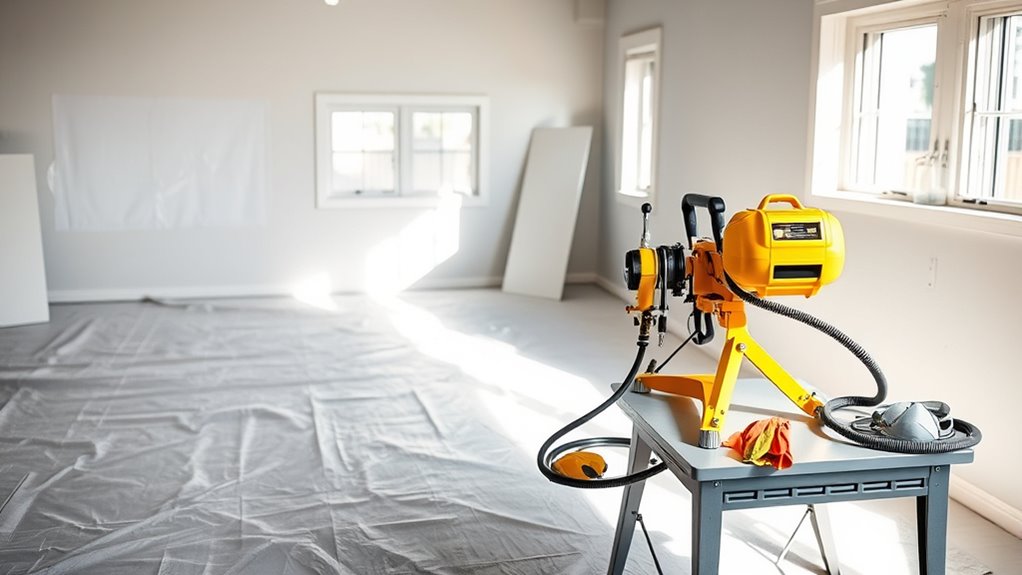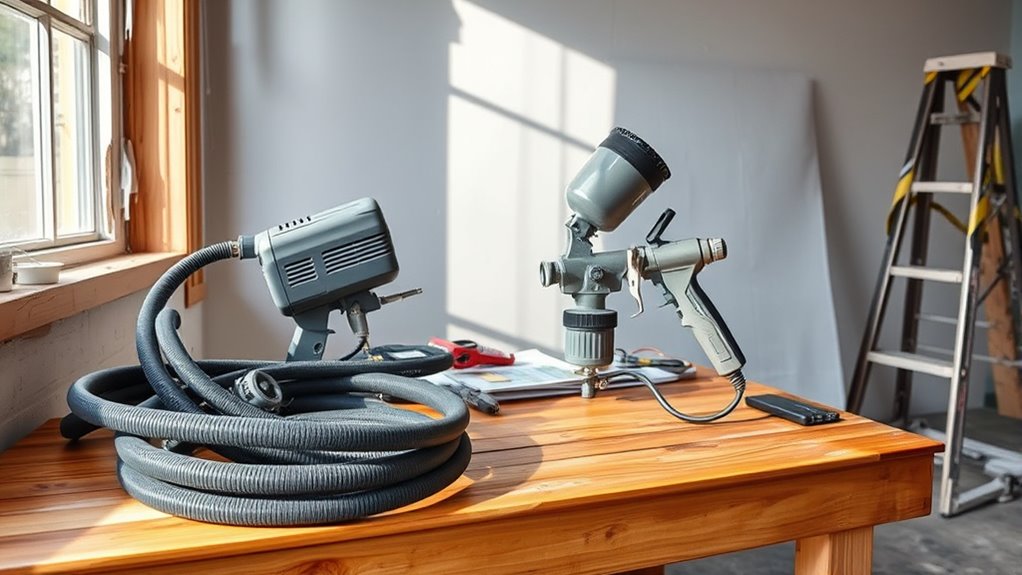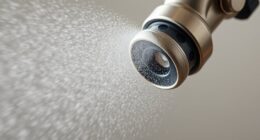To set up your work area for an airless spraying project, start by organizing and clearing the space of any objects that could be damaged or interfere with your work. Cover furniture and floors with drop cloths or plastic sheeting to protect surfaces from overspray. Wear proper protective gear like a respirator, safety glasses, gloves, and coveralls. Make certain good ventilation with fans or open windows to remove fumes and dust. Keep fire extinguishers nearby and use adequate lighting for safety and precision. Learn the key steps to get started smoothly.
Key Takeaways
- Organize and clear the workspace, covering surfaces and removing obstacles to prevent overspray damage.
- Wear appropriate protective gear, including respirators, safety glasses, gloves, and coveralls.
- Set up proper ventilation with fans or open windows to remove fumes and overspray effectively.
- Keep a fire extinguisher nearby and eliminate ignition sources to ensure fire safety.
- Ensure adequate lighting for visibility, maintaining a well-lit, clutter-free environment for precision.

Setting up your work area properly is vital for achieving a smooth and safe airless spraying job. Before you even turn on the equipment, make sure your workspace is organized and prepared to minimize risks and maximize efficiency. One of the most critical steps is ensuring you have the right protective gear. Wearing a respirator designed for spray painting, safety glasses, gloves, and coveralls helps shield you from harmful fumes, overspray, and potential skin irritations. Protective gear isn’t just about complying with safety standards; it’s about safeguarding your health throughout the project. Take the time to inspect your gear for any damage or wear, and don’t skip this step. Proper protective equipment allows you to work confidently, knowing you’re protected from airborne particles and chemical exposure. Additionally, understanding the importance of airless spraying technology can help you operate your equipment more effectively and safely. Equally important is setting up a proper ventilation system. Good ventilation ensures that fumes, overspray, and dust are effectively removed from your work area, reducing health hazards and improving the quality of your finish. If you’re working indoors, open windows and doors to create cross-ventilation. Using exhaust fans or portable ventilation units can considerably enhance airflow, pulling contaminated air away from you and dispersing it outside. Position these fans strategically to direct fumes out of the workspace without blowing overspray onto surfaces or furniture. Ventilation setup isn’t just about comfort — it’s a vital safety measure that prevents the buildup of hazardous vapors and helps you maintain a clean and safe environment. Clear the area of any unnecessary objects, especially items that could be knocked over or damaged by overspray. Cover nearby furniture, floors, and fixtures with drop cloths or plastic sheeting to protect surfaces from paint and reduce cleanup time. Make sure your work area has adequate lighting, so you can see your work clearly and avoid mistakes. Also, keep a fire extinguisher nearby, especially if working with flammable materials or solvents, and ensure that the workspace is free from ignition sources.
Frequently Asked Questions
How Do I Dispose of Leftover Paint Safely?
To dispose of leftover paint safely, you should follow proper paint container disposal and waste paint management practices. First, try to use all the paint or donate leftover amounts if possible. If not, let the paint dry out completely by exposing it to air or adding a paint hardener. Once hardened, place the dried paint in your regular trash. Always check local regulations for specific disposal rules to guarantee environmental safety.
Can I Use the Same Workspace for Different Projects?
Yes, you can use the same workspace for different projects if you keep it well-organized. Use storage solutions like labeled bins and shelves to separate supplies and prevent cross-contamination. Maintain good workspace organization by clearing clutter between projects, and designate specific areas for each task. This approach helps you work efficiently, reduces cleanup time, and guarantees safety, making your workspace versatile and ready for any project.
What Personal Protective Equipment Is Essential?
Think of your safety gear as your armor in a battle against paint and fumes. You must wear protective clothing to shield your skin and a respirator mask to guard your lungs from harmful overspray and vapors. These essentials keep you safe, allowing you to focus on your masterpiece without worry. Never skimp on personal protective equipment—it’s your first line of defense in every airless spraying project.
How Do I Prevent Overspray in Tight Spaces?
To prevent overspray in tight spaces, you should use drop cloths to cover nearby surfaces and masking tape to secure protective coverings on edges and fixtures. Keep the spray tip close to the surface and maintain steady, controlled movements. Adjust your spray pressure and angle, and work slowly to avoid overspray. These steps help you stay precise and protect surrounding areas effectively.
What Ventilation Measures Are Recommended During Spraying?
You should use a ventilation fan to promote airflow and reduce fumes during spraying. Additionally, incorporate air filtration systems to capture airborne particles and improve air quality. Keep the ventilation fan running continuously, especially during and after spraying, to clear out fumes quickly. guarantee proper placement of fans and filters to maximize efficiency, and always wear appropriate respiratory protection to stay safe.
Conclusion
Now that you’ve set up your work area, you’re ready to tackle your airless spraying project with confidence. Think of your workspace as the stage where your skills will shine—prepared, organized, and primed for success. Remember, a well-planned setup isn’t just a detail; it’s the foundation for a smooth, flawless finish. With everything in place, you’re not just spraying paint—you’re creating a masterpiece. So, go ahead, make your mark with precision and pride.










